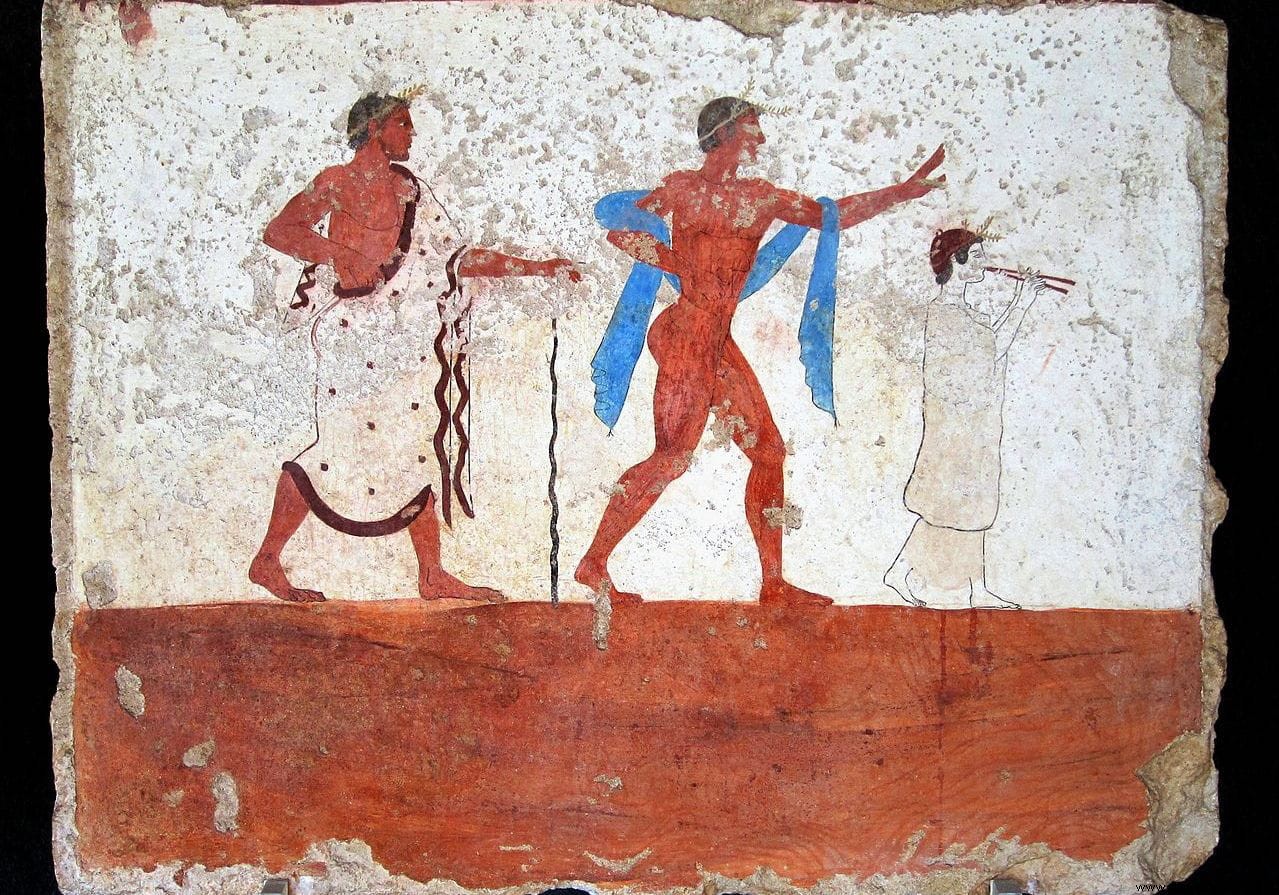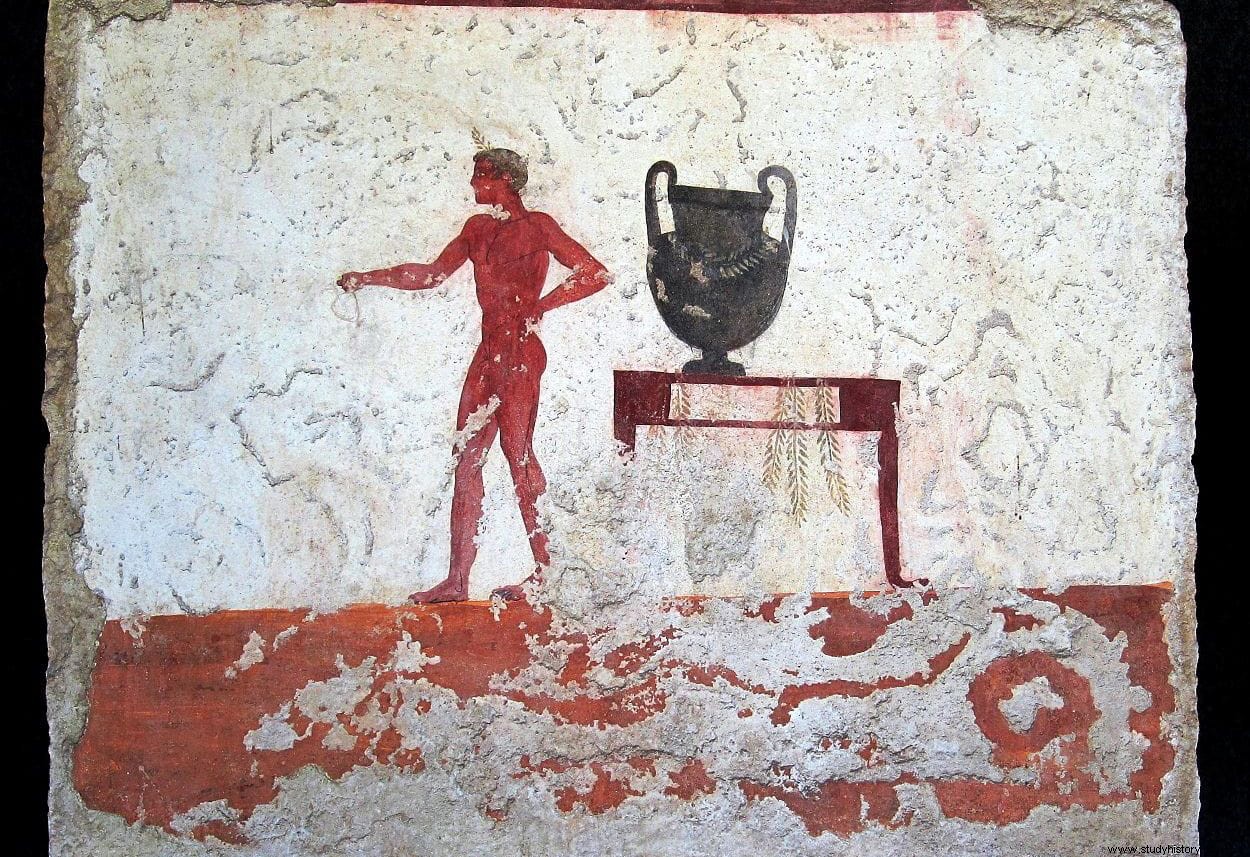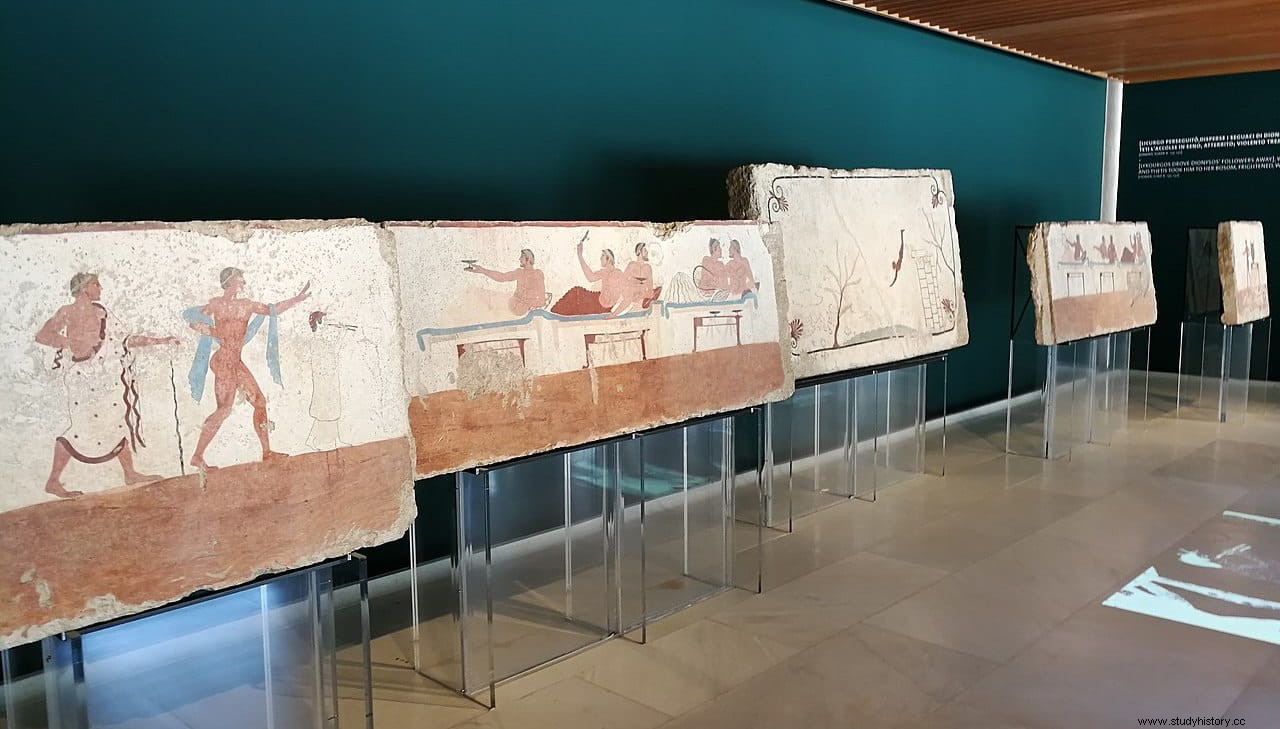On June 3, 1968, while excavating a small necropolis from the 6th-5th century B.C. In the area known as Tempa del Prete, 1.5 kilometers from the site of the ancient Greek city of Posidonia (called Paestum by the Romans), in southern Italy, archaeologist Mario Napoli made an exceptional discovery.
He found a tomb dated to around 480-470 BC. with five large limestone slabs, which form the walls and ceiling, while the floor is carved out of the natural bedrock. The five slabs were carefully plastered together to form a niche 2.15 meters long by 1 meter wide and 80 centimeters high.
But the real treasure was found on the inside of the slabs, decorated with frescoes. In the four that formed the walls, a symposium scene (traditional male banquet among the Greeks, but also the Phoenicians, Etruscans and other Mediterranean peoples) is represented.

And on the ceiling an image that has no parallel in the art of Greek Antiquity:a solitary figure jumping from columns to dive into the water, a river or the sea represented as a curly and undulating current. Almost all scholars agree that the plunge does not have a literal meaning but would be a symbol of the passage from death to the afterlife.
The place from which he jumps would allude to the mythical columns of Hercules that marked the end of the known world and symbolized the limit of human knowledge. According to its discoverer, Mario Napoli, the athletic pose, so close to the pedestal as to make the immersion seem like a flyover, would symbolize the transit towards a world of knowledge .
It is this fresco that has given its name to the tomb, known as the Tomb of the Swimmer, in Italian more specifically Tomba del tuffatore (jumper, diver). According to the researchers, these frescoes represent the only known example of fresco mural painting in Greek art of archaic and classical antiquity with figurative representations.

On the north and south walls, five reclining figures participating in the symposium are represented. They all wear garlands or crowns and are drinking or playing musical instruments. One of the figures is playing cótabo, a Greek game that involved throwing the rest of the cup's liquid at a predetermined target. Another carries between her fingers a white object that appears to be an egg, a probable reference, according to Mario Napoli, to the Orphic-Pythagorean cults.
On the west wall three figures appear to be entering or leaving the symposium (perhaps they are late), an older man carrying a cane, a young man with a himation, and a woman playing a flute. The east wall shows a solitary servant holding an oenochoe, a jug used to draw wine from a larger container, like the krater on the right.

Inside the tomb were the remains of a young man, which pulverized when it was opened, along with an Attic lekythos (oil jug) decorated with black figures, two alabaster ointment jars, and some fragments of tortoise shell, which they were probably part of the soundboard of a lyre. It is not known who was the individual buried there, but it must have been a person of some wealth, since among the paintings the Egyptian blue pigment has been detected, which was expensive to obtain and very expensive.
Researchers are still debating whether the tomb is Greek or whether it belongs to a local tribe that predates the arrival of the Greeks. Those who defend this last hypothesis are based on the exceptionality of the frescoes, since no other Greek tomb with a similar figurative ornamentation has been discovered, and in fact it was not the Greek custom to paint the tombs.

Those who defend that it is Greek indicate a possible influence or inspiration in the Etruscan tombs (with a very clear reference in the Tomb of Hunting and Fishing, from the 6th century BC, where the motif of the jumper also appears), decorated with motifs similar, since at that time the Etruscans were settled north of the Sele River, very close to Paestum.
However, the stylization and abstraction of the diving scene differ from the naturalism that pervades Etruscan tomb paintings. And both the iconography and its representation are typically Greek.

The existence of a local tradition in Posidonia (Paestum) of tomb painting is attested by the discovery, in recent decades, of some twenty painted tombs from between the end of the 6th century and the beginning of the 5th century BC. However, none of them contain figurative scenes. Yes, some tombs with figurative decorations have been found in the area, but not Greek, but after the conquest of the city by the Lucanians, an Italic tribe.
The frescoes from the Swimmer's Tomb can now be seen on display at the National Archaeological Museum of Paestum.
Fonts
American Journal of Archeology | Rouveret, Agnes . La Tombe du Plongeur et les frescoes étrusques:témoignages sur la peinture grecque . Revue Archéologique, no. 1, Presses Universitaires de France, 1974, p. 15–32, jstor.org/stable/41744366 | Daisy Warland , What does the freshness of the paroi Ouest de la tombe au plongeur de Poseidonia represent? , Kernos, 12 | 1999. doi.org/10.4000/kernos.721 | Alberghina MF, Germinario C, Bartolozzi G, Bracci S, Grifa C, et al . (2020) The Tomb of the Diver and the frescoed tombs in Paestum (southern Italy):New insights from a comparative archaeometric study . PLOS ONE 15(4):e0232375. doi.org/10.1371/journal.pone.0232375 | Mario Napoli , The tomb of the tuffatore | Wikipedia
